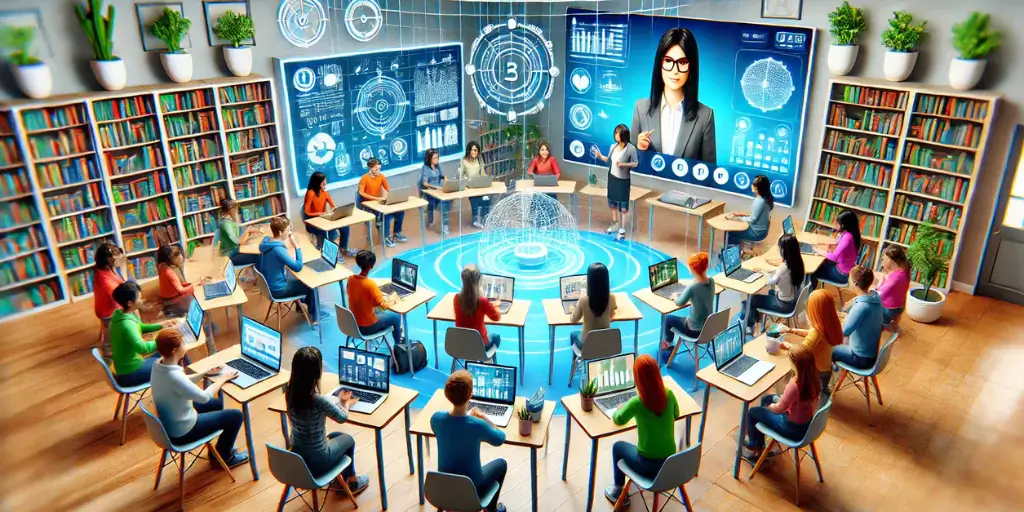In today’s fast-paced digital age, education is rapidly transforming with the use of Artificial Intelligence (AI). What once appeared like science fiction—robots assisting teachers, predictive systems for student performance, or tailored learning paths—is now a reality in schools all around the world.
Let’s look at how AI is transforming education for students, teachers, and institutions.
What is Artificial Intelligence in Education?

Artificial intelligence in education is the application of smart technologies such as machine learning, natural language processing, and data analytics to improve learning outcomes, automate administrative activities, and create personalised learning experiences.
From adaptive learning systems to virtual instructors, artificial intelligence is making education more accessible, efficient, and inclusive.
Key Applications of AI in Education
1. Personalised Learning

One of the most noteworthy benefits of AI is its ability to tailor learning experiences to individual students’ requirements. AI systems can use a student’s learning style, skills, and shortcomings to generate personalised courses and practice sessions.
For example, platforms such as Khan Academy and Duolingo employ artificial intelligence to adapt course difficulty based on user performance.
2. Virtual tutors and chatbots

AI-powered tutors and bots are available 24 hours a day, seven days a week, to answer student inquiries and provide assistance when teachers are unavailable. These technologies alleviate student dissatisfaction and increase participation.
For example, AI tutors can help clarify arithmetic topics, explain grammatical rules, and provide on-demand practice quizzes.
3. Automatic Grading

AI can grade multiple-choice examinations, fill-in-the-blank questions, and even essays with more accuracy. Educators can now spend more time teaching and mentoring.
Turnitin and Grammarly, for example, use AI to identify plagiarism and provide writing advice.
4. Smart Content Creation

AI can help create digital textbooks, summaries, flashcards, and even immersive experiences through augmented reality (AR). These technologies allow students to study more effectively and engagingly.
5. Predictive Analysis for Student Performance

AI systems can evaluate student data to identify those who are at risk of failing or dropping out, allowing teachers to intervene early. It also helps colleges plan their curriculum based on performance trends.
6. Language Translation and Accessibility

AI techniques such as real-time translation and speech-to-text aid in breaking down language barriers and improving accessibility for students with disabilities.
Google Translate and Microsoft Immersive Reader, for example, help bilingual students and those who struggle with reading.
Benefits of AI in Education

- Enhanced student involvement
- Effective administration
- Quicker grading and feedback
- Improved accessibility
- Data-driven decisions
Challenges and Ethical Concerns

While AI provides numerous benefits, it also introduces obstacles such as:
- Data Privacy Concerns
- Bias in algorithms.
- Overdependence on technology.
- High implementation costs in rural areas.
To ensure the effectiveness and ethical use of AI in education, transparent platforms with human oversight and equitable access must be developed.
The Future of AI in Education

The usage of AI in education is only anticipated to increase. As technology advances, we may see:
- AI Mentors for Lifelong Learning
- Voice-activated classroom assistants.
- AI-personalised VR lessons.
- Global classrooms using AI interpreters
Education powered by AI promises to be more student-centred, adaptable, and inclusive, preparing students not only for tests but also for a dynamic future.
Conclusion
Artificial intelligence is changing schooling in extraordinary ways. AI is making education smarter and more successful by personalising learning journeys and lessening the strain on instructors. To realise its full potential, it is critical to resolve ethical problems and ensure fair access for all.







Josephhaula
July 14, 2025I am assured of it.
——
https://hosting.estate/tags/%D0%B7%D0%BE%D0%BD%D0%B0%20%D0%B4%D0%BE%D0%BC%D0%B5%D0%BD%D0%B0/
Josephhaula
July 14, 2025Your idea is magnificent
——
https://www.krauteracademy.de/group/blute-blatt-gruppe/discussion/a5a0746b-af6a-4ac3-b17c-e61c4aa17610
EdwardEdume
July 14, 2025It is a pity, that now I can not express – it is compelled to leave. I will be released – I will necessarily express the opinion on this question.
——
https://the.hosting/de/help/distributiv-damnsmall
tải 188v
July 14, 2025Sản phẩm casino trực tuyến tại tài xỉu 66b nhà cái được xem là sân chơi đẳng cấp, vị trí hàng đầu tại châu Á. Anh em dễ dàng tìm kiếm đa dạng thể loại bài, từ truyền thống cho tới tựa game hiện đại, từ sản phẩm hiếm gặp cho tới phổ biến.
888slot link
July 14, 2025888slot apk Sảnh game xổ số, lô đề tại đây nổi tiếng với độ uy tín và trả thưởng sòng phẳng, xanh chín. Do vậy mọi người hoàn toàn có thể yên tâm tin tưởng tham gia cá cược thỏa mãn niềm đam mê của mình. Đồng thời tất cả các game đều được chúng tôi sử dụng thuật toán RNG ngẫu nhiên đảm bảo tính công bằng 100%.
888slot app
July 14, 202566b club Sảnh game xổ số, lô đề tại đây nổi tiếng với độ uy tín và trả thưởng sòng phẳng, xanh chín. Do vậy mọi người hoàn toàn có thể yên tâm tin tưởng tham gia cá cược thỏa mãn niềm đam mê của mình. Đồng thời tất cả các game đều được chúng tôi sử dụng thuật toán RNG ngẫu nhiên đảm bảo tính công bằng 100%.
Andrewshext
July 14, 2025https://findycarcom.mystrikingly.com/
66b
July 14, 2025Truy cập vào link chính thức của 188v con để tải ứng dụng. Link này đảm bảo bạn có thể tải ứng dụng một cách an toàn và không gặp phải các vấn đề về bảo mật.
CraigDug
July 14, 2025купить номер для телеграмма